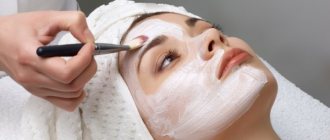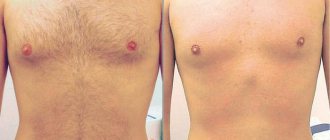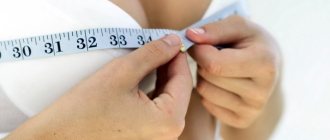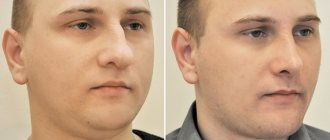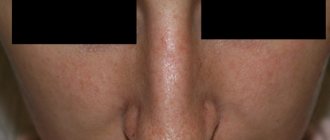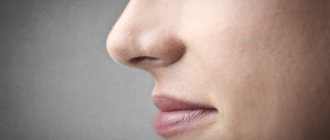Your nose should breathe freely
A deviated septum often comes as a surprise to many people. They categorically deny any past injuries and have no idea where this defect came from. Curvature can appear as a result of birth trauma, improper development of the skull, etc. The cartilage of the nasal septum is surrounded by bone tissue, and can outstrip it in growth, so various bends or irregularities can form in the process.
Patients are often skeptical about doctor’s recommendations for surgical correction. Many people claim that they breathe normally, but during the conversation it turns out that difficulties still exist, and not entirely harmless ones. In this way, people snore in their sleep, breathe with an open mouth, and do not smell. After a successful operation, the patient discovers something that he had not felt before. For example, he never knew how delicate the scent of roses was or the smell of the air after rain.
What is septoplasty
This is a surgical procedure to help straighten a deviated nasal septum. Basically, such an operation is prescribed not for aesthetic, but for medical reasons. But most often, patients undergo septoplasty together with rhinoplasty.
Why does the patient have a deviated nasal septum?
There may be several reasons for this:
- bad heredity;
- frequent injury to this area;
- improperly performed cosmetic surgery;
- the patient has tumors, polyps, benign and malignant neoplasms;
- the patient develops rickets and other ailments dangerous to his health.
During the procedure:
- adjacent tissues are practically not injured;
- the risk of a person developing blood poisoning and infection in a wound is reduced;
- and after it the patient does not need to apply stitches to the treated area;
- the effect lasts only 1-2 minutes, and after the operation itself the lady recovers very quickly;
- the doctor carries out all the manipulations very quickly, so the risk of the patient bleeding is minimal;
- and after it the patient rarely experiences complications. They can only arise if the procedure was performed in an unverified clinic by a doctor with low qualifications;
- which is necessarily carried out in a hospital setting; the patient does not need to stay in the clinic for a long time.
Indications for rhinoplasty
The operation is performed in cases where the patient needs:
- Correct the nostrils, make them smaller or narrower.
- Remove a natural hump on the nose or a protrusion caused by an injury.
- Change the size of the nose and its shape.
- Correct a drooping, thickened, hooked or upturned nose.
- Eliminate various defects, both congenital and acquired.
- Correct pathologies of the nasal septum.
The main indication for rhinoplasty is the patient’s dissatisfaction with his appearance, namely his nose. As a rule, flaws in appearance prevent people from living a full life and achieving their desired goals, since they cause complexes and a feeling of inferiority.
Reasons and indications
As mentioned above, septoplasty is performed for various reasons.
It is carried out if the patient has:
- breathing problems, oxygen starvation, increased fatigue, frequent headaches;
- disturbances in the sense of smell;
- frequent nosebleeds;
- secondary diseases. These include chronic rhinitis, sinusitis, tonsillitis, otitis media, frontal sinusitis, laryngitis, acute respiratory infections;
- chronic swelling of the nasal mucosa;
- sinusitis, dryness, itching in the nasal cavity;
- loud snoring, noisy breathing, frequent apnea, occurring most often at night.
In addition, the procedure is carried out when:
- polyps, greatly enlarged adenoids;
- vasomotor rhinitis. This disease is characterized by the appearance of severe swelling on the nasal mucosa;
- the presence of a foreign body in the nasal cavity. Very often, the nasal septum is bent in those ladies who have previously had their nose pierced.
According to statistics, about 80% of Russian citizens have a deviated nasal septum. Of course, small changes are hardly noticeable, do not spoil a person’s aesthetic appeal, and do not have a negative impact on his health. Therefore, with such disorders, the patient rarely consults a doctor. But if a deviated septum interferes with a person’s normal breathing, then he should see a specialist immediately.
More information about septoplasty
Dear patients, it is difficult to cover all issues related to the treatment of a deviated nasal septum in one publication. You can ask them to me personally in WhatsApp chat, messages (to the specified phone number) or the YandexKnowledge service - I try to answer quickly, depending on the current workload in the operating room.
You will also find additional information about septoplasty in other publications on the site. They are listed below.
Sincerely, otorhinolaryngologist, surgeon Ph.D. Bocklin.
Types, methods and principles of septoplasty surgery
Conventionally, doctors divide septoplasty into several main types.
A patient can undergo septoplasty:
- Classic.
- Endoscopic.
- Laser.
- Radio wave.
- Ultrasonic.
Let's look at each operation in more detail.
Classic septoplasty is a surgical operation that helps correct the shape of the nasal septum. During the operation, the doctor uses a special medical scalpel. He cuts the nasal mucosa and gets to the cartilage. Only after this the specialist aligns the nasal septum. Sometimes he removes it completely, corrects it and reinserts it.
The procedure lasts 1 hour. But for 12 hours the patient is not recommended to eat, take medications, alcoholic beverages, or blood thinners.
After the operation, a special mesh is placed on the patient’s nose. It prevents the cartilage from shifting. After 1 year, the mesh dissolves on its own.
Remember: classical septoplasty is considered an outdated method of treatment, so patients undergo it very rarely. After such exposure, a person has to recover for a very long time, and he may also develop complications that are dangerous to his health.
Endoscopic septoplasty is in particular demand among patients. This operation does not injure neighboring tissues, and after it the patient recovers very quickly. During the operation, the doctor uses a special probe. He inserts it into the nasal cavity. Next, this device is illuminated, and the picture through a special camera conveys everything that the doctor is doing inside. The doctor then makes several incisions. It is with their help that he gains access to the nasal septum.
Before the operation, the patient must be given local anesthesia and general anesthesia. But the choice of anesthesia is made by a physician. It depends on the patient’s health status, his wishes, the presence of contraindications, and chronic diseases.
Next, the specialist pulls out the deformed area through the holes.
After the operation, the doctor places special tampons in the patient’s nose. They can be removed after 1 day.
Endoscopic septoplasty usually takes 1-2 hours.
Laser septoplasty is also in particular demand among users. During this procedure, tissues are cut very quickly, and rehabilitation takes very little time. Complications after such an operation occur extremely rarely in patients. And during the operation, the patient never bleeds. Therefore, the risk of infection is minimal, because The laser not only cuts tissue, but also disinfects the damaged area. He also seals damaged vessels.
This procedure is usually performed under local anesthesia. The uniqueness of the procedure is that it is carried out using a video endoscope.
This procedure has positive properties, but it is carried out only when there is severe curvature of the cartilage. For example, this procedure will not help get rid of deformed bone structures.
In general, the effect lasts 30 minutes.
Radio wave septoplasty is also in particular demand among citizens. During it, the doctor slightly incises the mucous membrane, removes the deviated nasal septum, and corrects the deformed areas. After correction, the nasal septum is placed in its original place. The procedure is carried out using a video endoscope and a special radio wave device, Surhydron. This is a special radio wave knife.
The uniqueness of radio wave septoplasty is that during the procedure no blood is produced in the patient. And it is performed more often than laser septoplasty. Radio wave septoplasty helps correct the shape of bone structures. But such an effect cannot be achieved by other correction methods.
Patients actively use ultrasound septoplasty. The procedure is unique in that during it the mucosal tissue is excised very quickly. And later they are sealed with a special beam, so during the procedure the patient does not bleed. Moreover, ultrasound septoplasty is considered a non-surgical method for correcting the shape of the nose. This procedure helps to get rid of severe curvature, growths, and thorns. The ultrasonic device has high power, so it helps to get rid of even serious problems.
Rhinoplasty. What will your nose tell you?
Aesthetic dissatisfaction with appearance can greatly influence a person’s self-esteem, especially when it comes to the face. The consequences of youth trauma and the peculiarities of individual development lead to imperfections in the shape of the nose, which becomes far from the canons of beauty. A plastic surgeon knows how to remove a hump, correct the tip of the nose, correct wide nostrils, or generally change the shape. But to get a decent result, you need to approach the issue comprehensively, and now we will analyze in detail why.
Preparation for septoplasty
Only an otolaryngologist can prescribe surgery. But before the procedure, the patient must pass all the necessary tests and undergo a full examination.
He will need to submit:
- general analysis of urine and blood;
- blood test for the presence of viral diseases. For example, hepatitis, HIV;
- allergy test. Using it, the anesthesiologist can determine whether the patient is allergic to the drugs injected into his body;
- X-ray of the nasal cavity. But only a doctor can prescribe it.
Additionally, the patient will have to take an electrocardiogram and go to a consultation with a cardiologist or therapist.
In addition, the patient will have to follow special recommendations.
For example, he will have to:
- 3 weeks before the procedure, stop smoking;
- 2 weeks before surgery, stop drinking alcohol. He will also need to stop using non-steroidal drugs and blood thinners;
- 10 days before the procedure, avoid visiting the solarium and being exposed to open sunlight.
Possible complications
Among the most severe complications after rhinoplasty are: the appearance of suppuration, infections and sepsis, but they occur only in isolated cases.
Typical complications are considered to be the appearance of postoperative adhesions, breathing problems, deviated nasal septum, partial or complete loss of smell, as well as patient dissatisfaction with the result.
According to statistics, almost every fifth corrected nose has to be redone due to unpredictable fusion of cartilage and bones or because the patient does not like something.
When assessing the results of plastic surgery, you should remember that it is not always possible to achieve ideal symmetry, so you should not expect that the nose will look exactly the way it was modeled on a computer when planning the operation.
The model created on a computer is only a kind of guide for the doctor during the operation, but even the best surgeon will not be able to calculate the result down to the millimeter, since human tissues do not have stability and high plasticity.
Author: Irina Vaganova, doctor, especially for Moylor.ru
Stages of septoplasty
During the procedure, the woman must be put under anesthesia. It can be general, local, combined.
In general, the operation consists of the following main stages.
Doctor:
- Makes several small incisions inside the nasal cavity. Such incisions heal very quickly, and after surgery they are practically invisible.
- Separates the osteochondral frame from the soft tissues. Only in this way will the doctor be able to carry out further correction.
- Corrects or straightens the nasal septum, displaces bone and cartilage fragments, and removes excess tissue.
- Fixes tissues with tampons, splints, and applies sutures.
In general, the entire operation lasts from 1 to 3 hours.
Open rhinoplasty
This type of nose correction surgery differs in that to perform the manipulations, the nose must be “opened” by cutting the skin in the places where the nostrils connect to the upper lip, as well as on the columella, which is the partition between the openings of the nose.
After this, the skin is lifted, exposing the entire osteochondral structure of the nose for the necessary manipulations.
If a complex intervention is required, for example, in case of a broken nose, then the operation is performed in an open way, this allows you to assemble the entire inside of the nose piece by piece and reconstruct the organ.
No experienced surgeon will perform a complex operation without free access to damaged tissues.
In this case, the issue of postoperative scars is secondary, since the doctor’s priority task is to ensure that the nose, after rhinoplasty and reconstruction, grows together correctly and there is no need to perform a second operation.
There is no need to worry about the scars that may remain after such an operation, since a surgeon with sufficient experience will hide the stitches in the natural folds of the skin located at the base of the nose, while the incision made on the columella is sutured microsurgically, so in the future it will almost will not be visible.
In addition, the scars after open rhinoplasty, which many patients fear, are a thin line, no thicker than a sewing thread, which becomes invisible over time.
Contraindications
Septoplasty is a truly beneficial procedure that helps get rid of many deficiencies. But it is not possible for all patients.
For example, it is not performed if the patient has:
- acute infectious diseases;
- oncology;
- diabetes mellitus;
- autoimmune diseases;
- severe aggravated ailments localized in internal organs;
- poor blood clotting.
Also, the procedure is not performed on women who are pregnant or breastfeeding. It is also not performed on patients under 18 years of age.
Remember: if a woman is at risk, then she will have to forget about this operation. Together with a physician, she can find other alternative methods of influence that have a similar effect.
Secondary rhinoplasty
This procedure is more of a treatment step than a type of rhinoplasty and is usually performed in cases where it is impossible to solve the patient’s problem in one procedure.
For example, when performing surgery on children to correct nasal deformities, first an operation is performed to eliminate the breathing problem, and then, when the facial bones have fully grown and the skull is formed, a secondary operation is performed to eliminate aesthetic defects.
But much more often, secondary rhinoplasty is performed to correct any mistakes made during the main procedure or in cases where complications arose during the tissue healing process.
Moreover, during a secondary operation it is often necessary to rebuild the structure of the nose again. In some cases, patients themselves insist on performing a secondary operation if they are not satisfied with the result obtained or when they want to correct something else.
Postoperative period
The patient should stay in a medical facility for the first 1-2 days after surgery. In this case, he may experience severe pain, swelling, hematomas, and an increase in body temperature. This is fine. In this case, the patient is not prescribed additional treatment.
In the hospital, the patient will have to take painkillers and anti-inflammatory drugs.
For 2-3 days after the operation, the patient will have to walk with tampons or splints in the nose. They will contain special tubes through which the patient will breathe. Moreover, you cannot delete them yourself. The patient can only breathe through the mouth. Therefore, during this period, doctors recommend that he drink more fluids. The oral cavity can quickly dry out from such breathing.
Full nasal breathing is restored 5-7 days after removing the tampons. During this period of time, the nose should be injured and should not be touched again. You need to perform hygiene procedures, sneeze, scratch, and rub your nose very carefully. You can't blow your nose too much.
For the first 2-3 weeks after surgery, the patient should adhere to the following simple rules.
He needs to give up:
- sports, physical exercise;
- visits to the sauna, bathhouse;
- smoking;
- alcoholic drinks;
- spicy food.
During rehabilitation, the patient will have to give up wearing glasses, bending forward, and traveling by plane. Also, the patient will have to sleep only on his stomach.
Remember: if the patient is experiencing severe pain, he can take a painkiller. But doctors do not recommend doing this. The body must cope with all illnesses on its own.
To make breathing easier, the patient may be prescribed nasal medications. They help cleanse the nasal cavity and relieve swelling. Oxymetazoline is usually prescribed.
3 days after exposure, the patient can remove the tampons from the nasal cavity. But the nasal mucosa will still be swollen. Although the person’s breathing will improve. But this can only be done after consultation with a specialist.
During the entire rehabilitation period, it is important for the patient to carefully monitor his well-being. If he has bleeding or other unpleasant symptoms, they should be eliminated immediately. The patient recovers completely 1 month after exposure.
During rehabilitation, the patient must take vitamin and mineral complexes. They will help strengthen human immunity. Moreover, you can take them at any time of the year.
After the operation, the patient must follow all the doctor’s recommendations. Otherwise, he may experience complications that are dangerous to his health.
Him:
- Heavy bleeding may occur.
Typically, blood appears in those patients who, during the rehabilitation period, took:
- blood thinning medications;
- alcoholic drinks;
- hot drinks.
Bleeding may also occur in those patients who, during the rehabilitation period, bent over strongly, slept on their stomachs, or engaged in active sports.
Patients usually experience bleeding in the first 1-2 days after surgery. This is considered normal and there is no need to treat such conditions in any way.
If the patient has severe nosebleeds, then he should insert a tampon into the nasal cavity. It will help stop the bleeding.
Closed rhinoplasty
This operation is performed inside the nasal cavity using a special scalpel and without making external incisions. The work can rightfully be called jewelry work, requiring highly qualified doctors.
As a rule, a specialist with sufficient experience knows two methods of performing surgery, both open and closed, and selects the necessary method for each specific patient based on the indications that need to be eliminated.
During a closed operation, there are no scars left on the patient’s face, since all the stitches are located on the inside of the nasal cavity, but during such an operation the surgeon does not have access to all tissues. For this reason, a closed operation cannot be performed in cases where a person needs to assemble a broken nose, remove a large hump, or connect cartilage fragments.
You can often hear talk that if a surgeon has sufficient experience in performing rhinoplasty, then he can perform any operation in a closed manner, but this is not true and is only a kind of speculation on the fears of many patients about the appearance of scars on the face after an open operation.
In fact, a doctor with extensive experience always decides for himself which method to use in each specific case in order to solve the problem as effectively as possible.

